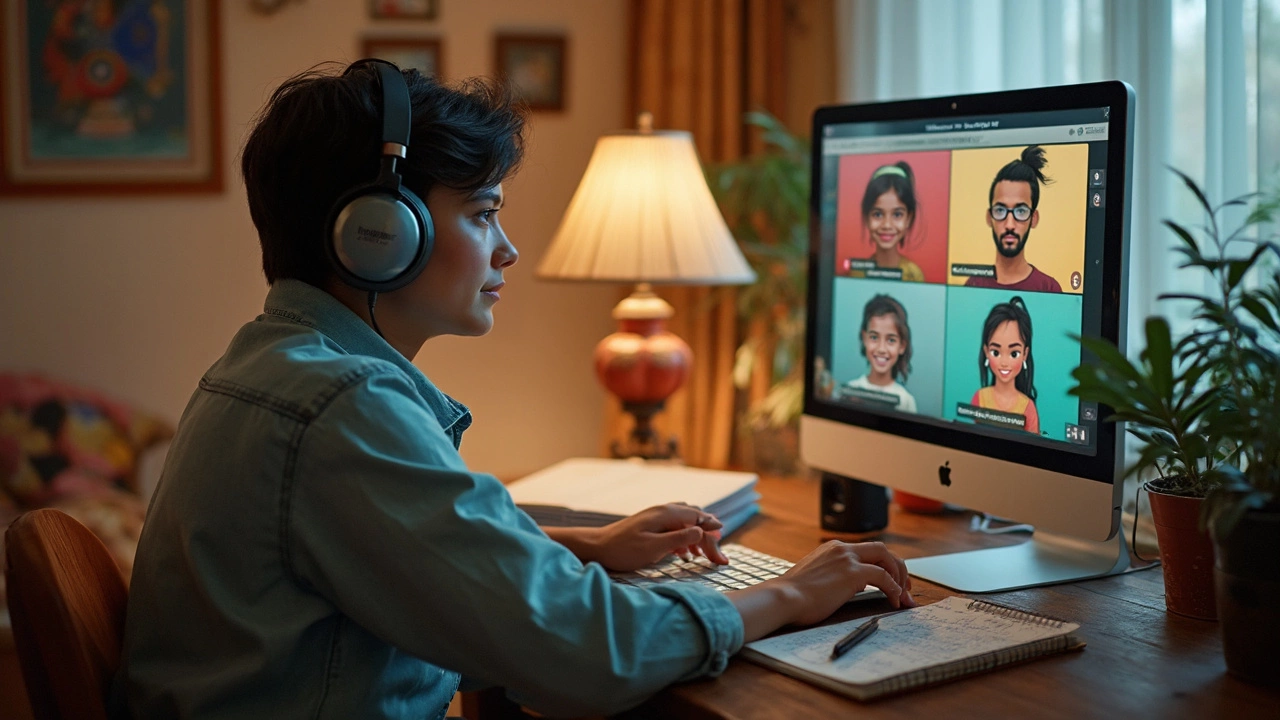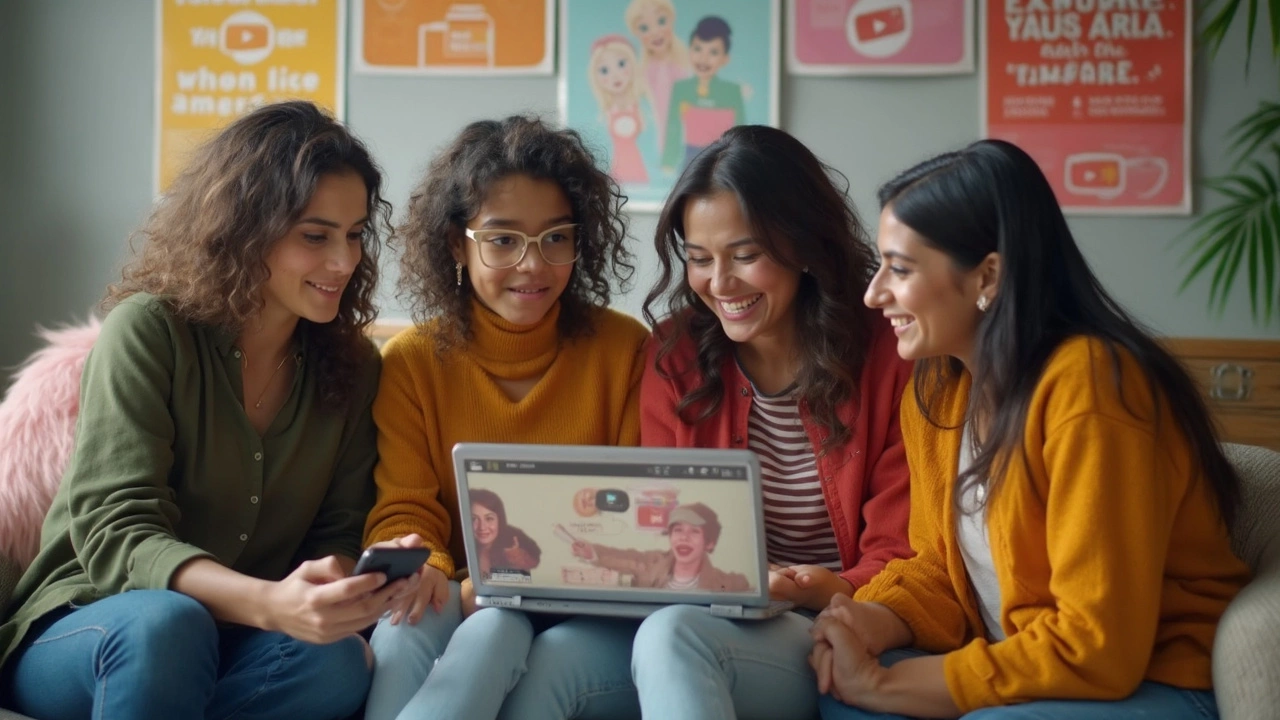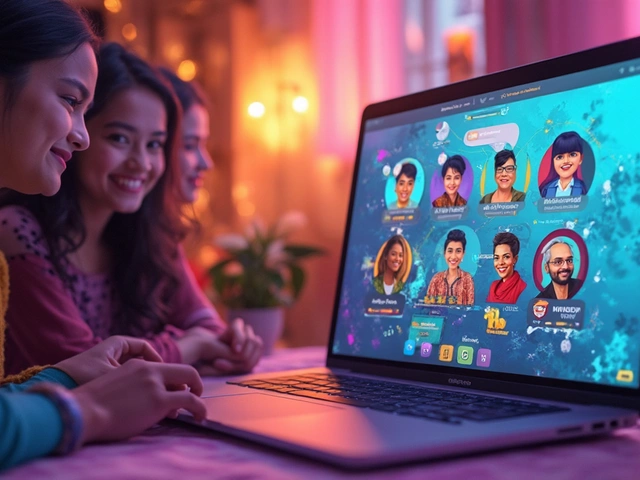Learning spoken English online isn’t just about watching videos—it’s about finding the channel that speaks your language, literally and figuratively. YouTube is packed with English tutors and influencers, but not all of them are built for people who want to speak confidently in real life. Some channels focus on exam tricks. Others give long grammar lectures that put you to sleep. The trick? Zero in on the channels that actually show how real people talk, explain things simply, and engage you with loads of everyday examples.
It’s easy to think you need a fancy course with textbooks and long assignments. Truth is, YouTube’s free stuff can be just as powerful if you know where to look—and how to use it. Some channels make you feel like you’re chatting with a friend, breaking down tricky phrases and pronunciation without making it awkward or dull. It’s not about memorizing rules; it’s about picking up the stuff people actually say on the street, at work, and with friends.
- Why YouTube Works for Spoken English
- Top Channels to Consider
- Channel Breakdown: Who’s It For?
- How to Use YouTube for Real Progress
- Extra Tips for Getting Fluent Faster
Why YouTube Works for Spoken English
YouTube is a game changer for people who want to boost their spoken English skills, and there’s no shortage of reasons why. You’re not tied to a classroom. You can get lessons anytime, anywhere, and pause or rewind if you miss something. Maybe the best part? You can see and hear real people using English in everyday settings, with all the slangs, accents, and natural rhythms that just don’t show up in textbooks.
Forget boring grammar drills—YouTube’s massive library means you can pick the kind of content you actually care about, from short conversation clips to long Q&A sessions. And you can watch a lesson multiple times until it totally clicks. Most channels also throw in subtitles, so you can read along and catch every word.
YouTube makes it easy to follow native speakers and teachers from all over the world. Want to hear British, American, or Australian English? You’re covered. There’s something cool about seeing how people really speak—mistakes, slang, jokes and all. That’s the stuff that makes you comfortable in actual conversations.
Here’s what sets YouTube apart for spoken English:
- You get access to countless free channels
- Lessons are short, focused, and often fun
- You can listen to a range of accents
- Interactive comments help you ask questions and get instant tips
- Practice with transcripts, quizzes, and live sessions
YouTube is more than just a video platform—it’s a global classroom. Check out some numbers that show just how big this is:
| Fact | Detail |
|---|---|
| Monthly Users | Over 2.5 billion (as of 2024) |
| Educational Channels | 50,000+ focused on English learning |
| Average Daily Watch Time | 30 minutes per viewer |
| Content Variety | Conversation, pronunciation, storytime, interviews, and live Q&As |
No other platform puts so many spoken English options at your fingertips. Every kind of learner has a shot at finding the perfect match. You’re never too far from a video that can teach you how people actually talk—no textbook required.
Top Channels to Consider
So, which YouTube channels walk the talk when it comes to helping you actually learn spoken English? Here are some of the biggest names people trust, with millions of views and real user comments to back them up. These are not just classroom-style lessons—you’ll notice the teachers break things down with real examples and useful phrases.
- English With Lucy – Lucy’s channel is huge, and for good reason. She uses short, practical lessons for daily conversations, pronunciation, and British vs. American English. Her ‘Phrases Native Speakers Use’ videos get millions of views. She’s relatable and explains stuff like it’s a chat, not a lecture.
- Rachel’s English – If you want to sound more natural, Rachel focuses almost completely on American pronunciation. She’s got close-up mouth demonstrations, which sounds weird but actually helps. Her channel, closing in on 4 million subscribers, even has street interviews with real Americans.
- EnglishAddict with Mr. Duncan – Mr. Duncan’s style is energetic and fun. He’s been at this for ages (since 2006!) and covers everything from slang to news headlines. His live lessons make you feel involved, and he really cares about making English easy.
- Speak English With Vanessa – Vanessa’s lessons focus on English for everyday life—ordering food, having casual chats, and even disagreeing politely. Her video comments sections are super active, so you know people are really learning and discussing the content.
- RealLife English – With teachers from different countries, they break down tough expressions and real-world English, sometimes even featuring locals from the street. Their ‘Learn English with TV Series’ playlists are a hit for anyone who likes learning through pop culture.
Here’s a quick breakdown so you can compare:
| Channel | Main Focus | Subscriber Count (2025) | Unique Feature |
|---|---|---|---|
| English With Lucy | Conversation, pronunciation | 12M+ | British & American comparison |
| Rachel’s English | Pronunciation, American accent | 3.9M | Mouth demonstration, street interviews |
| EnglishAddict with Mr. Duncan | Everyday topics, slang | 1.1M | Lots of live lessons |
| Speak English With Vanessa | Daily conversations | 4.7M | User-friendly, practical tips |
| RealLife English | Native expressions, TV/movie clips | 4.5M | Focus on real conversations |
Each of these channels updates regularly, answers user questions, and shares tips for learners at all levels. If you try one and it doesn’t click, just hop to another—find the teaching style and accent you vibe with. YouTube’s best part? The freedom to switch until something finally clicks and you start speaking up, not just listening along.

Channel Breakdown: Who’s It For?
You want the best spoken English YouTube channel, but let’s be real—one size never fits all. Different channels are built for different needs. Here’s how a few popular picks stack up, so you can match your style with the right vibe, fast:
- English with Lucy: If you love a step-by-step breakdown and crystal-clear British pronunciation, Lucy’s your go-to. Her channel is packed with lessons on pronunciation, idioms, and even slang. She’s easy to understand and tons of her stuff is great for beginners and intermediate speakers.
- Learn English With TV Series: Ever wanted to talk like a character from “Friends” or “The Office”? These guys teach using real scenes from TV shows. It’s a fun way to catch real expressions and modern phrases, perfect for people who get bored with textbooks.
- Rachel’s English: This one is gold for pronunciation. Rachel uses slow-motion breakdowns and mouth close-ups (not as weird as it sounds) to help you nail tricky American sounds. You’ll notice a big improvement in your accent and clarity, especially if you feel stuck at the "understand but can’t speak smoothly" stage.
- EnglishAddict with Mr. Duncan: Mr. Duncan has a relaxed, conversational style—great if you hate uptight classrooms. He talks about daily life, news topics, and even feelings, so you actually get how English sounds in different situations. His channel’s been around since 2006, so it’s full of gems.
According to a recent YouTube Learner Insights report (2024), about 60% of language learners say they stick with channels where teachers feel "personable and relatable." That’s probably why the channels above get millions of subscribers.
| Channel Name | Focus | Best For | Subscriber Count (2025) |
|---|---|---|---|
| English with Lucy | Pronunciation, Vocab, Accent | Beginners, Intermediate | 11M |
| Rachel’s English | American Pronunciation | Accent & Clarity Seekers | 4M |
| Learn English With TV Series | Real-life Phrases, Listening | Conversational Learners | 8.2M |
| EnglishAddict with Mr. Duncan | Daily English, Conversation | Everyday Speaking | 1.1M |
Here’s how you can figure out which channel fits:
- If you’re a total beginner, start with a channel like "English with Lucy" for a gentle introduction to basics.
- If you want to sound like a native, dig into "Rachel’s English" for accent tweaks.
- If you get bored easily, try "Learn English With TV Series" for entertainment plus learning.
It helps to sample videos from each channel before you commit. As language coach Mark Thomson puts it:
“Your perfect channel is the one that makes you forget you’re studying—it feels like hanging out. If you’re not clicking with a teaching style, keep searching. There’s a perfect match for everyone on YouTube.”
How to Use YouTube for Real Progress
YouTube’s packed with English speaking content, but watching random videos won’t make you fluent. What really works is building a habit and working smart, not just hard. Here’s how people actually get real results from these channels:
- Choose channels that focus on real spoken English. Look for ones that use common, everyday language—think Learn English With TV Series or English With Lucy. Skip the old-school grammar-only videos unless you’re stuck on something specific.
- Don’t just sit and listen. Pause the video, repeat sentences out loud, and mimic the speaker’s tone and style. Repeating after native speakers has been shown to boost pronunciation and confidence.
- Turn on subtitles, at first. They help you catch words and get used to hearing how English flows. Turn them off later to boost listening skills.
- Set a daily time—just 10 to 20 minutes—and treat it like brushing your teeth. Consistency is the secret sauce. Data shows that people who practice daily improve up to 5x faster than those studying only once a week.
- Write down and use 2-3 new phrases from every video. Use them in your own voice notes or during your day. This cements what you learn.
- Join the comments section. It may sound silly, but commenting on videos in English nudges you to write and think fast.
Platforms like EngVid and Speak English With Vanessa offer full playlists based on levels, so you can start easy and crank up the difficulty. Don’t try to follow too many channels at once—stick to one or two until you notice clear progress. Here’s a quick table to compare what helps and what slows people down:
| Habit | Impact on Progress |
|---|---|
| Daily, focused practice | Fast, steady improvement |
| Only watching passively | Slow, little progress |
| Talking back to videos | Boosts speaking skills |
| Jumping between many channels | Confusion, less progress |
People who treat YouTube like a real teacher—asking questions, pausing, repeating, writing down new stuff—see the best results. Remember, it’s not about finishing the most videos, it’s about understanding and using what you watch.

Extra Tips for Getting Fluent Faster
If you want to get good at spoken English quickly, watching videos isn’t enough. Sure, YouTube channels are handy, but real progress means practicing and building some good habits outside the screen.
One thing most learners skip? Talking out loud, even when you’re alone. Sounds silly, but research shows that talking to yourself in English helps lock in vocabulary and boosts speaking confidence. A 2024 EF English Proficiency Index study found that students who practiced speaking daily for just 10 minutes reached conversational fluency 30% faster than those who stuck only to passive listening or reading.
- Spoken English gets way easier if you focus on chunks, not single words. For example, learn whole phrases like “How’s it going?” or “Mind if I join you?” instead of just random words. You’ll sound way more natural.
- Shadow the videos—literally repeat and copy what the speaker says, matching their tone and speed. This method, known as “shadowing,” is used by pro interpreters to pick up accents and flow.
- Record yourself and play it back. It can feel awkward, but you’ll instantly spot what sounds off—and fix it.
- Mix up your sources. Listen to podcasts, join English-speaking Discord servers, or use voice chat apps. Exposure to different accents and topics stops you from feeling lost in real talks.
- Practice small talk in real life—even texting friends, voice messaging, or commenting on videos helps break the ice.
Here’s a quick table with rough estimates on how fast different habits can improve spoken English, based on recent community surveys:
| Practice Habit | Estimated Weekly Time | Expected Progress (1 month) |
|---|---|---|
| Watching YouTube lessons only | 3 hours | Basic understanding, slow improvement |
| Shadowing + Speaking daily | 5-6 hours | Noticeable fluency boost |
| Mix of video, real talking, and recording | 7+ hours | Major gains in confidence and flow |
No secret formulas—just consistency and using your English every chance you get. The more you use it, the faster you’ll break through that awkward stage and start owning regular conversations.





Write a comment